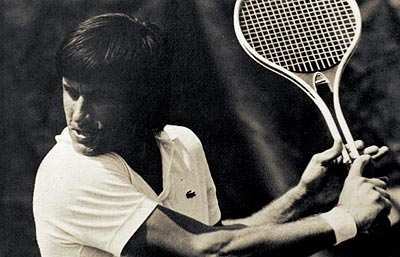Tennis had a fraught relationship with apartheid-era South Africa, but it didn’t have much of a problem with South African money. At precisely the same time that South Africa made a controversial appearance in Davis Cup play in Montevideo, half of the top stars in the men’s game hopped on airplanes to take them from Brussels to Johannesburg. Just two weeks after their arrival in Europe, the men of World Championship Tennis’s Group A were swapping continents again.
Lamar Hunt’s WCT circuit was on the hook for six-figure prize money guarantees for many of its big-name players. The South African metropolis offered a $50,000 pot at the Clows Classic. No matter that the traditional tour stop in Monte Carlo took place at the same time and would have made for a much more sensible journey from Belgium. That event was outside of Hunt’s orbit, so the gang crossed the equator instead.
There was little, if any, concern about what the trip represented. Arthur Ashe was the only Black player of note in men’s tennis. He was–conveniently enough–part of the other half of the WCT troupe, which spent the week in Charlotte, North Carolina. He didn’t have to worry about South Africa’s racist immigration policy or, if they let him in, grapple with whether he should go. Rod Laver didn’t play, but he was clearly struggling with a back injury. Protesters around the world were outraged when South African teams arrived in their countries for a visit, but there was much less argument when American and European stars made a quick jaunt to Jo’burg for a paycheck.
That didn’t mean the 5,500-mile detour was easy. Immediately upon arrival, the seeds began to fall. Stan Smith, riding a 20-match win streak, went on court 18 hours after his plane touched down. 19 hours after arrival, he was out of the tournament, a 6-2, 6-2 victim of Puerto Rican veteran Charlie Pasarell.
Pasarell was more famous for his marathons. In 1968 at the US National Indoors, he and Ron Holmberg lost a six-and-a-half-hour doubles match. A year later, he nearly upset Richard González in the Wimbledon first round, falling in a five-hour duel of big servers, 22–24, 1–6, 16–14, 6–3, 11–9. He was named the top-ranked American in 1967, but by 1973, he was essentially a journeyman, more likely to last to the weekend in doubles than in singles.
On the first day of play in Johannesburg, he served as well as ever. Smith was “tired and listless,” double-faulting away the final point of the match.
Fatigue got to some other stars, too. Fourth seed Roy Emerson and fifth seed Dick Stockton also lost on opening day. Cliff Drysdale, the top-ranked South African, managed just five games against Rhodesian Andrew Pattison. None of the top ten seeds would even reach the semi-finals. Even Pasarell didn’t last another round.
The lackluster play probably wasn’t any kind of protest against apartheid, but it was still a kind of statement. After the Johannesburg event was over, the troupe would make a U-turn, playing the following week in Gothenburg, Sweden. And the tournament that the top men really cared about–the WCT Finals in Dallas–was only a few weeks away. Contractual obligations prevented men like Smith, Laver, and Emerson from taking a break. The only way to get a breather was to lose early.
It was a long season. No one would scoff at the $10,000 winner’s check, but compared to the laurels available over the next few months, the prestige of a title at the Clows Classic was a sacrifice worth making.
* * *
This post is part of my series about the 1973 season, Battles, Boycotts, and Breakouts. Keep up with the project by checking the TennisAbstract.com front page, which shows an up-to-date Table of Contents after I post each installment.
You can also subscribe to the blog to receive each new post by email:
